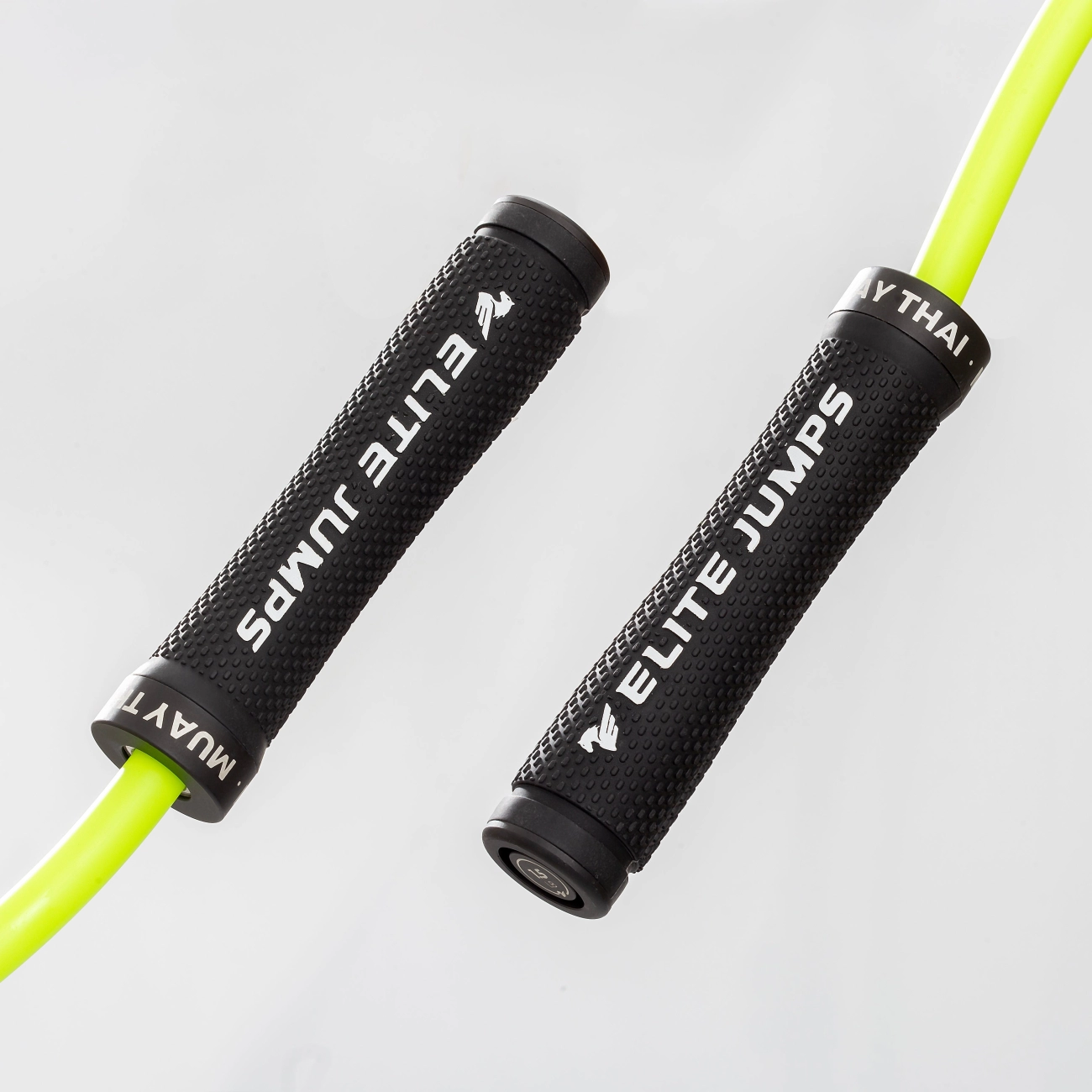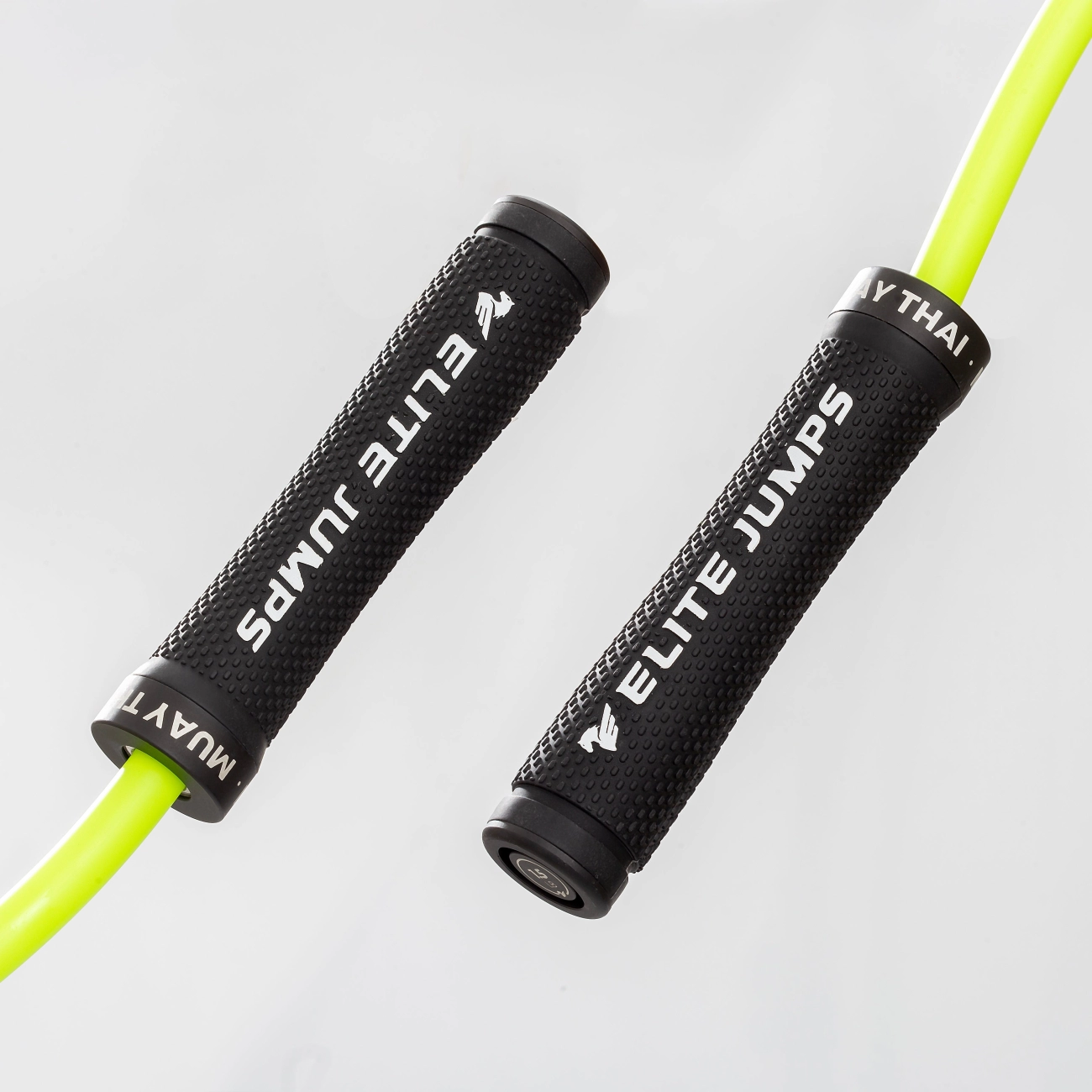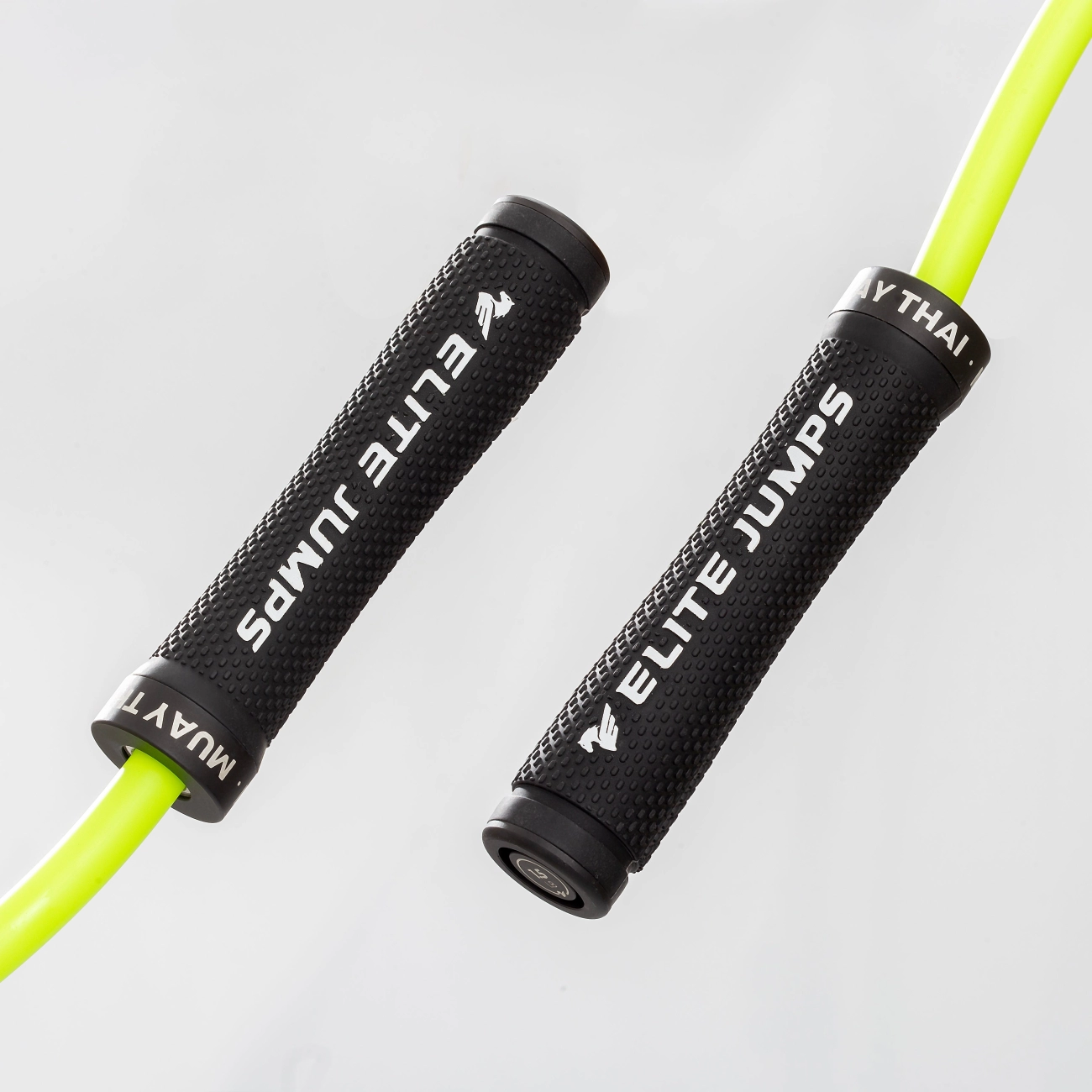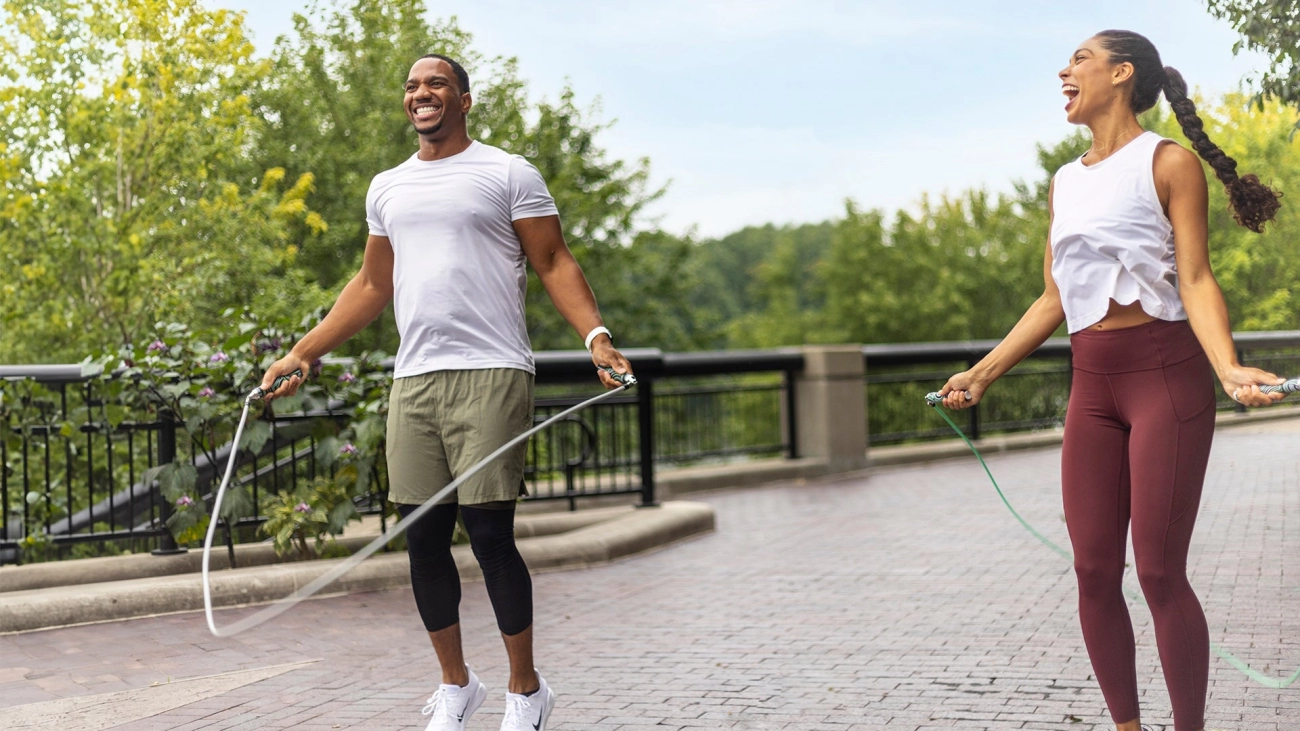Basic Jump Rope Techniques for Beginners
Starting with the right jump rope techniques for beginners sets a solid foundation for your fitness journey. Mastering these basics helps avoid injury and builds the coordination needed for more advanced moves.
Single Bounce Basic Jump
The single bounce or basic jump is the simplest jump rope move and the perfect starting point.
-
How to do it
- Stand with feet hip-width apart and hold handles at waist level.
- Swing the rope over your head and jump once as it passes under your feet.
- Land softly on the balls of your feet and keep knees slightly bent.
- Maintain a steady, relaxed rhythm.
-
Common mistakes to avoid
- Jumping too high causing unnecessary impact. Aim for just enough height to clear the rope.
- Using the arms to swing the rope instead of wrists – wrists should do most of the work.
- Poor posture such as slouching or leaning forward. Keep your back straight and head up.
- Holding breath or tensing up; stay relaxed for smooth movement.
Alternate Foot Step Jogging Step
The alternate foot step or jogging step is an excellent next step after the single bounce.
-
Benefits for endurance
- Increases cardiovascular endurance with a lower impact on joints.
- Mimics a jogging motion, making it easier to keep a steady pace for longer sessions.
-
How it helps transition to advanced moves
- Builds rhythm, timing, and foot coordination.
- Prepares you for quicker footwork needed in moves like double unders.
-
How to perform the step
- Jump off one foot while the other foot stays slightly raised behind.
- Alternate feet with each rope swing in a steady jogging rhythm.
- Keep your jumps low and light for quicker turnaround.
Side to Side Jump
The side to side jump develops coordination and rhythm while adding variety to your routine.
-
Why it matters
- Challenges your balance and foot control, essential for jump rope progress.
- Keeps workouts dynamic and engaging.
-
How to do it
- Jump with both feet together, moving your body gently side to side as the rope passes.
- Keep your knees soft and avoid overextending your lateral movement.
- Focus on staying light on your feet and maintaining a consistent pace.
Mastering these basic jump rope exercises will boost your confidence and prepare you for intermediate and advanced moves. For the best experience, choosing the right jump rope is key — check out the 10 Foot Skipping Rope for a reliable beginner-friendly option.
Intermediate Jump Rope Moves to Boost Your Workout

Once you’re comfortable with basic jump rope techniques for beginners, it’s time to step up your game with intermediate jump rope moves. These exercises will enhance your coordination, cardio endurance, and overall fitness. Let’s break down some popular intermediate moves, focusing on form, technique, and benefits.
Boxer Step Jump Rope Technique and Fitness Benefits
The Boxer Step is a classic jump rope move inspired by how boxers stay light on their feet. It involves shifting your weight from one foot to the other with a slight hop, while the rope swings under both feet continuously.
-
How to do it:
- Start with both feet together.
- As the rope swings, hop onto your left foot.
- Then shift and hop onto your right foot.
- Keep your jumps low and light to conserve energy.
-
Benefits:
- Improves foot speed and balance.
- Builds endurance without excessive impact.
- Prepares you for faster, more complex footwork.
High Knees Jump Rope for Cardio and Intensity
Adding High Knees during your jump rope workout cranks up the intensity and targets your core and lower body.
-
Proper form:
- Jump rope normally, but instead of landing with both feet together, raise your knees to waist height alternately.
- Keep your back straight and engage your core.
- Use your arms to maintain rhythm.
-
Training tips:
- Start slow to avoid losing rhythm.
- Increase speed gradually to boost cardio benefits.
- This move significantly improves cardiovascular health and leg strength.
Criss Cross Jump Rope for Hand Coordination
The Criss Cross is a fun move that challenges your hand-eye coordination and timing. It adds variety and improves your rope control.
-
Step-by-step guidance:
- Jump with both feet as usual.
- As the rope swings down, cross your arms in front of you.
- Uncross your arms on the next swing.
- Keep your elbows close to your body to maintain control.
-
Why it’s useful:
- Enhances upper body coordination.
- Helps develop rhythm and timing for advanced tricks.
- Adds upper body engagement to your workout.
For additional tips on perfecting the crossover jump, check out Tips for Crossover Skipping Rope.
Double Unders Mastery for Advanced Conditioning
Double Unders are when the rope passes under your feet twice with one jump — a challenging but highly effective move for conditioning.
-
How to progress:
- Start with consistent single jumps at a faster pace.
- Practice whipping the rope faster using your wrists, not your arms.
- Jump slightly higher than normal to allow the rope to pass twice.
- Focus on a steady rhythm and quiet landings.
-
Training tips:
- Don’t rush; speed up only when your timing is spot-on.
- Incorporate double unders in intervals for cardio boost.
- Regular practice improves agility, speed, and aerobic capacity.
Mastering double unders can be tough but rewarding. For the best jump ropes suited for speed and double unders, explore JumpRopeWholesale’s product range.
Adding these intermediate jump rope techniques to your routine ensures you get a comprehensive, fun, and challenging workout that builds your fitness progressively. These moves sharpen your coordination, boost cardiovascular endurance, and open the door to advanced jump rope skills.
Advanced Jump Rope Techniques for Experts
Once you’ve mastered the basics and some intermediate jump rope techniques, advanced moves help take your workout and skills to the next level. These moves challenge your coordination, timing, and overall fitness. Here’s a breakdown of some top expert jump rope techniques and how to train them effectively.
Triple Unders Jump Rope Technique
What it is
A triple under means the rope passes under your feet three times in one jump. It’s demanding but boosts your cardio, speed, and endurance big time.
How to train triple unders
- Start by mastering double unders to build speed and timing.
- Use wrist flicks, not arm swings, to spin the rope faster.
- Jump a bit higher than usual for extra clearance.
- Practice short sets — try 2 or 3 reps at a time, then rest.
- Build up gradually to avoid fatigue and injury.
Common pitfalls
- Jumping too low or too high.
- Using your whole arm instead of wrists, slowing the rope.
- Poor timing causing rope trips.
Focus on smooth wrist motion and consistent jumps to nail this move.
Side Swing Jump Rope for Coordination
The side swing adds variety and helps sharpen timing and hand-eye coordination. Instead of jumping over the rope, swing it sideways around your body.
Why practice side swings
- Improves rhythm and control.
- Helps transition between complex tricks.
- Builds upper body coordination.
Start slow and keep your elbows close to your sides. Once comfortable, add side swings between basic jumps to increase flow.
Backward Jump Rope Technique Benefits
Jumping rope backward is an excellent drill for agility, balance, and building a different muscle memory.
Benefits include
- Strengthens your calves and shins differently.
- Challenges your coordination by reversing rope timing.
- Improves overall jump rope skills and keeps workouts fresh.
Practice backward jumps in short bursts. Focus on steady rhythm; the backward rope swing will feel awkward at first but gets easier quickly.
Straddle Jump Rope Move Description
The straddle jump is a step up in agility and control, where you jump with feet wide apart (like a split) over the rope, then back together on the next jump.
Ideal training scenarios
- Use straddle jumps to build lateral leg strength and flexibility.
- Great for athletes and those wanting to increase coordination in all directions.
- Works well mixed into HIIT or intense jump rope sessions.
Practice on solid ground and keep your torso upright. Start slow to keep your timing and land softly.
Mastering these advanced jump rope moves requires patience and consistent practice but will significantly enhance your workout’s intensity, coordination, and overall fitness. Mix these techniques into your routine to keep your body adapting and your skills sharp.
How to Incorporate Different Jump Rope Methods into Your Routine

Building a well-rounded jump rope workout routine means mixing up your techniques to keep things fresh, challenge your body, and boost your fitness gains. Whether you’re a beginner or moving toward advanced jump rope moves, incorporating a variety of styles can improve your endurance, coordination, and overall cardio fitness.
Creating a Balanced Jump Rope Workout Plan
A good routine combines different jump rope techniques that target multiple fitness areas like endurance, agility, and speed. Here’s how to create that balance:
- Start with beginner basics like the single bounce or alternate foot step to build rhythm and confidence.
- Add intermediate moves such as boxer steps and high knees to increase intensity and calorie burn.
- Include advanced exercises like double unders or criss crosses to develop coordination and improve cardiovascular strength.
- Cycle through different styles during the workout to avoid overuse injuries and boredom.
- Focus on proper rest and active recovery between jump rope sets to maintain quality and form.
Combining Beginner Intermediate and Advanced Moves for Progression
Progression is key to staying motivated and improving your jump rope skills. By gradually adding more complex moves, you challenge your body to adapt while avoiding plateaus.
- Warm-up with beginner techniques for 3-5 minutes to get your muscles ready.
- Shift to intermediate moves in the middle of your routine, like high knees or the boxer step, for 5-10 minutes to boost cardio.
- End with advanced moves, such as double unders or criss crosses, for 3-5 minutes focusing on form and speed.
- Modify intensity and duration based on your current fitness level and recovery.
Sample Jump Rope Workout Plans From Beginner to Advanced
Here’s a quick look at how to structure your workout, depending on your skill level:
| Level | Workout Components | Duration | Notes |
|---|---|---|---|
| Beginner | Single bounce + alternate foot step | 10-15 minutes | Focus on rhythm, rest as needed |
| Intermediate | Boxer step + high knees + side to side jump | 15-20 minutes | Add short active rests (20-30 seconds) |
| Advanced | Double unders + criss cross + triple unders | 20-25 minutes | Push tempo, work in intervals |
By rotating these plans throughout the week, you create a varied and progressive jump rope workout that improves endurance, coordination, and fat burning.
Using this approach helps you make the most out of your jump rope workout routines, combining the best beginner, intermediate, and advanced jump rope techniques for a balanced and effective fitness plan.
Choosing the Right Jump Rope for Different Techniques
Selecting the right jump rope is crucial to get the most out of your skipping sessions. Whether you’re a beginner mastering basic jump rope techniques or an advanced athlete working on double unders and triple unders, your rope’s length, weight, and material play a big role in performance and comfort.
Rope Length Weight and Material Considerations
- Rope Length: A rope that’s too long or too short can throw off your timing and cause tripping. To find your ideal length:
- Stand on the center of the rope with one foot.
- Pull the handles up along your sides — they should reach your armpits.
- Weight: Heavier ropes add resistance, helping build strength and endurance, while lighter ropes favor speed and agility—perfect for fast moves like criss crosses or double unders.
- Material:
- PVC ropes are lightweight and quick, great for beginners and cardio workouts.
- Beaded ropes offer better rhythm and control, ideal for coordination exercises.
- Leather ropes are durable and provide a solid swing but are usually heavier, more suited for advanced jumpers.
Recommendations from JumpRopeWholesale’s Product Range
JumpRopeWholesale offers a wide range of ropes designed for various skill levels and goals:
- PVC Speed Ropes: Perfect for those focusing on cardio workouts with jumping rope or advanced jump rope moves requiring quick rotations.
- Beaded Jump Ropes: Great for beginners learning the basics and building coordination.
- Weighted Jump Ropes: Help improve power and endurance, suitable for strength training.
- Custom OEM/ODM Options: If you want to customize handles or rope length, JumpRopeWholesale supports tailored orders to fit your specific needs.
Tips for Maintaining and Customizing Your Jump Rope
Keeping your jump rope in good shape extends its life and improves your workout quality:
- Regularly check rope length and adjust as needed, especially if you share ropes or notice frequent tripping.
- Clean your rope handles and cable to prevent sweat buildup that can lead to wear.
- Lubricate rope bearings if your rope has them, to keep rotations smooth.
- Replace worn-out cables or beads to avoid injury.
- For personalized fit, consider swapping handles or adding grip tape—customizing makes your rope more comfortable and tailored for advanced jumps.
Choosing the right rope and maintaining it well sets you up for success across all jump rope techniques, from basic skipping to complex tricks and endurance training. JumpRopeWholesale’s diverse product variety makes it easy to find a rope that matches your workout style and skill level.
Common Jump Rope Mistakes and How to Avoid Them

Jump rope exercises are great for fitness, but poor technique can hold you back or even cause injury. Knowing the common mistakes and how to fix them is key to getting the most from your jump rope workout routine.
Poor Posture Hurts Efficiency and Safety
Many beginners overlook their body position. Slouching, leaning too far forward, or looking down can throw off balance and strain your back or neck.
- Stand tall: Keep your head up and shoulders relaxed.
- Engage your core: This stabilizes your body and helps maintain a smooth jump.
- Look straight ahead: Avoid looking at your feet or the rope to keep rhythm and control.
Incorrect Rope Length Creates Timing Problems
Using a rope that is too long or too short affects your jumping rhythm and can cause frequent tripping or inefficient jumps.
- Choose the right rope length: Generally, when you stand on the middle of the rope, the handles should reach your armpits.
- If you want a perfect fit, check out our guide on how long should a skipping rope be for detailed tips.
- Adjustable skipping ropes like the adjustable skipping rope are ideal for customizing the length based on your height and skill level.
Timing Issues Lead to Poor Execution and Fatigue
Jumping too fast or too slow throws off your workout flow. Incorrect timing can result in tripping, missed jumps, or excessive fatigue early on.
- Focus on rhythm: Maintain consistent, controlled jumps.
- Start slow: Master basic techniques before increasing speed or trying advanced jump rope moves.
- Practice foot coordination drills to build timing, like the Alternate Foot Step or Side to Side Jump.
How Wrong Techniques Can Lead to Injury
Skipping rope with bad form can stress joints, cause shin splints, or lead to wrist and ankle pain.
- Over-jumping: Jump only high enough to clear the rope to reduce impact.
- Improper landings: Land softly on the balls of your feet, not your heels.
- Poor wrist motion: Use your wrists, not your arms, to swing the rope to avoid shoulder strain.
- Avoid excessive forward bending which can compress your spine.
Solutions and Corrections for Safer Jump Rope Workouts
- Warm-up properly: Always start with a light warm-up to prepare muscles.
- Check your rope: Make sure your skipping rope suits your height and skill.
- Adjust your form: Use a mirror or video yourself to assess posture and timing.
- Gradually increase intensity: Avoid pushing too hard too soon.
- Use quality equipment: Consider options like the ball bearing skipping rope for smooth rotations promoting good rhythm.
By avoiding these common slip-ups and applying these corrections, you’ll enjoy safer, more effective jump rope sessions that build your fitness without injury. For more detailed tips, check out our comprehensive jump rope FAQs.
Frequently Asked Questions about Jump Rope Techniques and Benefits
What is the Best Jump Rope Technique for Weight Loss
When focusing on weight loss with jump rope, the key is maintaining consistent, high-intensity cardio. The best techniques include:
- Double Unders: These burn more calories fast by increasing jump speed and intensity.
- High Knees Jump: Adds cardio intensity and raises the heart rate.
- Alternate Foot Step (Jogging Step): Helps sustain longer sessions to burn calories steadily.
Combining these moves into intervals creates an effective jump rope workout routine to maximize fat-burning. Remember, consistent jumping for at least 15-20 minutes most days of the week drives results.
How Long Should Beginners Jump Rope Each Day
For beginners, ease into jumping rope properly with these guidelines:
- Start with 1 to 3 minutes of jumping per session, broken into manageable sets.
- Gradually increase to 10-15 minutes per day as your endurance and coordination improve.
- Aim for 3-5 sessions per week to see steady progress without injury.
If you’re new to skipping ropes, using a beginner-friendly rope and focusing on basic jump rope techniques for beginners can make a big difference. For a structured approach, check out this beginner skipping rope workout.
Can Jumping Rope Improve My Coordination
Absolutely. Jumping rope is excellent for improving coordination and timing because:
- It requires synchronizing hand and foot movements.
- Techniques like Criss Cross or Side to Side Jump further challenge your coordination skills.
- Regular practice enhances balance, rhythm, and reflexes.
This is why jump rope coordination exercises are popular among athletes and anyone wanting better motor skills.
How to Prevent Shin Splints When Jumping Rope
Shin splints are common but avoidable with these tips:
- Choose the right jump rope surface: Avoid hard concrete; use cushioning floors or mats.
- Wear supportive shoes with good shock absorption.
- Start slow and increase intensity gradually to build lower leg strength.
- Focus on proper form: keep your jumps low and land softly on the balls of your feet.
- Warm up and stretch your calves and shins before sessions.
If shin splints persist, reduce jumping time and try cross-training to prevent overuse injuries.
Jump rope is a versatile and highly effective fitness tool. Whether you’re a beginner or advanced jumper, mastering techniques and understanding your body’s limits will keep you safe and progressing. If you want more tips on how to pick the right rope or incorporate advanced moves like double unders, check out our resources on how to do a double under jump rope and rope selection advice.



